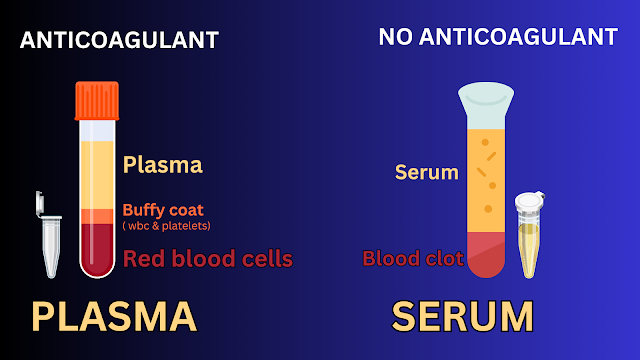How to Separation of Serum and Plasma? Questions about separating serum and plasma?
How to Separation of Serum & Plasma:
It is obtained by removing all formed elements from the anti-coagulated blood centrifuge at 2200-2500 RPM for 15 minutes or 5000 RPM for 3-5 minutes. This is required for the coagulation profile, Fibrinogen assay, etc.
Separation of Serum:
It is the fluid left behind after blood has clotted. It is the prevailing specimen necessary for chemical and serological tests. A standard test tube is employed for blood collection and blood is allowed to clot. Following this, the tube undergoes a gentle centrifugation process to yield a clear serum.
or
Centrifugation blood for serum-
- Draw 5 mL of whole blood for serum needed.
- Centrifuge for at least 15 minutes at 2200-2500 RPM or 5000 RPM for 3 – 5 minutes.
- Pipette the serum into a clean plastic screw-cap vial and attach the label.
Questions and Answers about separating serum and plasma:
General:
- What is the difference between serum and plasma?
- Why is it necessary to separate serum and plasma?
- What are the different methods for separating serum and plasma?
- What are the pros (advantages) and cons (disadvantages) of each method?
- What factors can affect the quality of separated serum and plasma?
Specific methods:
Centrifugation:
- What type of centrifuge is best for separating serum and plasma?
- What is the optimal centrifugation speed and time?
- How can I avoid contamination during centrifugation?
- Clot activator:
- What types of clot activators are available?
- What is the optimal amount of clot activator to use?
- How can I ensure complete clot formation?
- Gel separator tubes:
- What are the different types of gel separator tubes available?
- How do gel separator tubes work?
- What are the advantages and disadvantages of using gel separator tubes?
Additional questions:
- How can I ensure the sterility of separated serum and plasma?
- How should I store separated serum and plasma?
- How long can separated serum and plasma be stored?
- How can I dispose of biohazardous waste properly?
Troubleshooting:
- What can I do if I am unable to separate serum and plasma?
- What does it mean if my serum is cloudy or discolored?
- How can I avoid hemolysis during sample collection and processing?
- This list is not exhaustive, and you may have additional questions specific to your situation.
Answers to questions about separating serum and plasma:
General:
Difference between serum and plasma:
Serum: Fluid that separates from blood clot after coagulation. Doesn't contain clotting factors.
Plasma: Liquid portion of unclotted blood. Contains all blood components except red blood cells and platelets.
Necessity of separation:
Enables analysis of specific components without interference from other blood cells.
Serum is preferred for some tests due to the absence of clotting factors.
Separation methods:
Centrifugation: Most common method. Separates components based on density.
Clot activators: Chemical substances accelerate clotting, facilitating serum separation.
Gel separator tubes: Tubes containing a gel barrier that separates serum and plasma during centrifugation.
Advantages and disadvantages of methods:
Centrifugation: Efficient, but requires specialized equipment.
Clot activators: Simple and rapid, but may affect test results.
Gel separator tubes: Convenient and easy to use, but can be expensive.
Factors affecting quality:
Sample collection and handling procedures.
Centrifugation speed and time.
Temperature control.
Presence of interfering substances.
Specific methods:
Centrifugation:
Best centrifuge type: Refrigerated centrifuge with swing-out rotor.
Optimal speed and time: Typically 1,000-3,000 rpm for 10-15 minutes.
Preventing contamination: Proper handling of tubes and centrifuge.
Clot activators:
Types: Silica particles, calcium chloride, thrombin.
Optimal amount: Depends on type and instructions.
Ensuring complete clot formation: Incubation at room temperature for a specified time.
Gel separator tubes:
Types: SST (Serum Separator Tube), PST (Plasma Separator Tube).
Working principle: Gel barrier separates serum or plasma during centrifugation.
Advantages: Easy to use, reduces risk of hemolysis.
Disadvantages: Costly, potential for gel interference with some tests.
Additional questions:
Sterility: Use sterile collection tubes and maintain proper aseptic technique.
Storage: Store separated serum and plasma at an appropriate temperature (e.g., -20°C for long-term storage).
Storage duration: Varies depending on analyte and storage conditions. Generally, weeks to months.
Biohazardous waste disposal: Follow institutional guidelines for proper disposal.
Troubleshooting:
Unable to separate: Insufficient centrifugation time, incorrect speed, incomplete clot formation, contamination.
Cloudy or discolored serum: Hemolysis, improper storage, presence of lipemia.
Hemolysis: Avoid excessive pressure during blood collection, use correct anticoagulant tubes, and handle samples gently.
Note: This information provides a general overview. Specific protocols and procedures may vary depending on laboratory and test requirements. Always consult relevant manuals and guidelines for best practices.










No comments